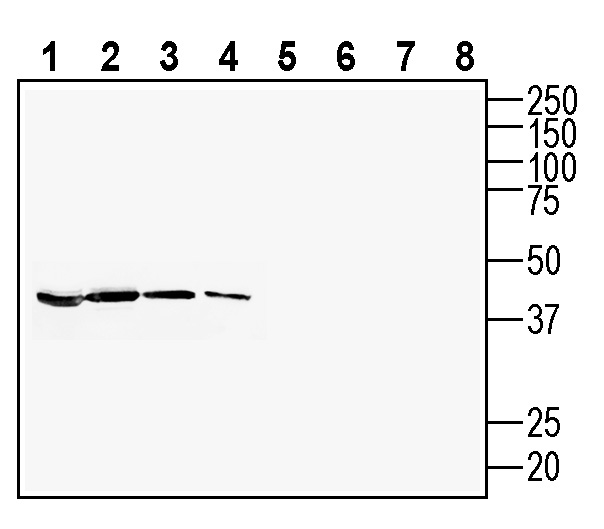Overview
- Peptide (C)DNFNVLPDTKERFYAS, corresponding to amino acid residues 297 - 312 of mouse NPSR1 (Accession Q8BZP8). Extracellular, 3rd loop.
Neuropeptide S Receptor (extracellular) Blocking Peptide (#BLP-NR029)
 Western blot analysis of mouse brain lysate (lanes 1 and 5), rat brain lysate (lanes 2 and 6), rat small intestine lysate (lanes 3 and 7) and rat lung lysate (lanes 4 and 8):1-4. Anti-Neuropeptide S Receptor (extracellular) Antibody (#ANR-029), (1:200).
Western blot analysis of mouse brain lysate (lanes 1 and 5), rat brain lysate (lanes 2 and 6), rat small intestine lysate (lanes 3 and 7) and rat lung lysate (lanes 4 and 8):1-4. Anti-Neuropeptide S Receptor (extracellular) Antibody (#ANR-029), (1:200).
5-8. Anti-Neuropeptide S Receptor (extracellular) Antibody, preincubated with Neuropeptide S Receptor (extracellular) Blocking Peptide (BLP-NR029). Western blot analysis of human THP-1 monocytic leukemia cell line lysate:1. Anti-Neuropeptide S Receptor (extracellular) Antibody (#ANR-029), (1:200).
Western blot analysis of human THP-1 monocytic leukemia cell line lysate:1. Anti-Neuropeptide S Receptor (extracellular) Antibody (#ANR-029), (1:200).
2. Anti-Neuropeptide S Receptor (extracellular) Antibody, preincubated with Neuropeptide S Receptor (extracellular) Blocking Peptide (BLP-NR029).
The Neuropeptide S Receptor (NPSR1), also known as GPR154, GPRA, or VRR1, belongs to the G protein-coupled receptor (GPCR) superfamily and is activated by neuropeptide S (NPS)1,2.
NPS is a 20-residue peptide, named due to the presence of a serine (S) residue in the N-terminal position of the molecule. NPS expression is limited to a few discrete brain areas, such as in isolated cells of the amygdala, the hypothalamus, and specific regions of the brainstem. The primary sequence of NPS is highly conserved among vertebrates especially at the N-terminus, which is crucial for biological activity. The positions 2, 3, 4, and 5 on N-terminus of NPS play important roles in bioactivity and activation of NPSR11,2.
The Neuropeptide S Receptor is widely distributed in the brain particularly in regions that are associated with regulation of stress response, memory, the olfactory system, and regulation of arousal. NPSR1 can signal via both Gq and Gs to increase cellular excitability and inhibit cell growth. Via the Gq pathway, NPSR1 leads to activation of Gq–phospholipase C and cleavage of phospholipid phosphatidylinositol 4,5-bisphosphate to inositol 1,4,5-trisphosphate (IP3) and diacylglycerol. IP3 activates IP3 receptor and releases Ca2 + from the ER. In some neurons, store-operated calcium channels are also activated, allowing entry of extracellular calcium into the cells 2.
In the Gs pathway, NPSR signaling activates adenylate cyclase, increased synthesis of cAMP, and activation of protein kinase A 2.
NPSR1 activation, like other GPCRs, also leads to activation of extracellular signal-regulated kinase 1/2 (ERK1/2) 2.
Knockout studies in mice demonstrated that the NPS system produces anti-aggressive effects, reduces social anxiety behavior, modulates fear response and enhances motor performance skills3,4.
A growing body of evidence suggests a close relationship between neuropeptide S and its receptor NPSR1 system in Parkinson's disease (PD). Indeed, administration of NPS to the central nervous syatem, ameliorates motor and non-motor dysfunctions in PD models, suggesting that targeting the NPS/NPSR1 system might be beneficial for Parkinson-related signs and symptoms 5.
